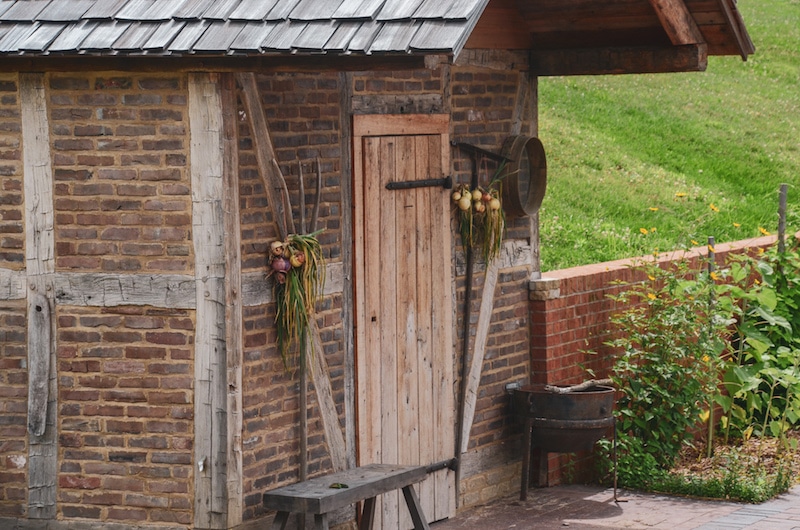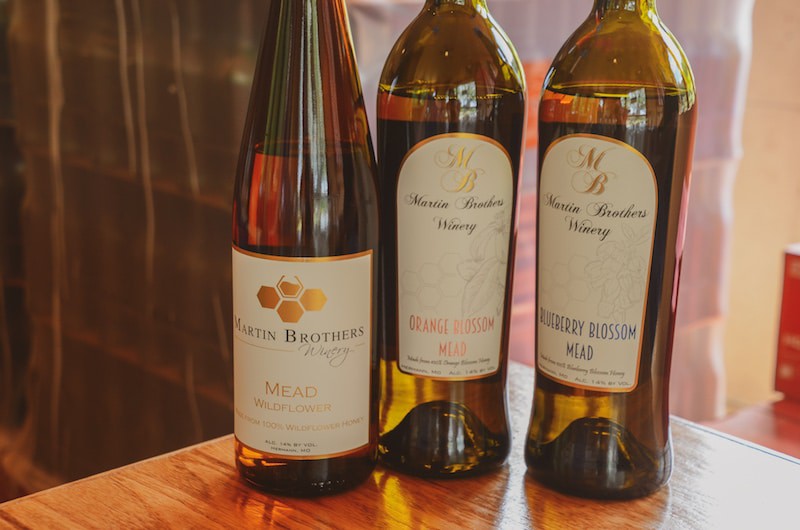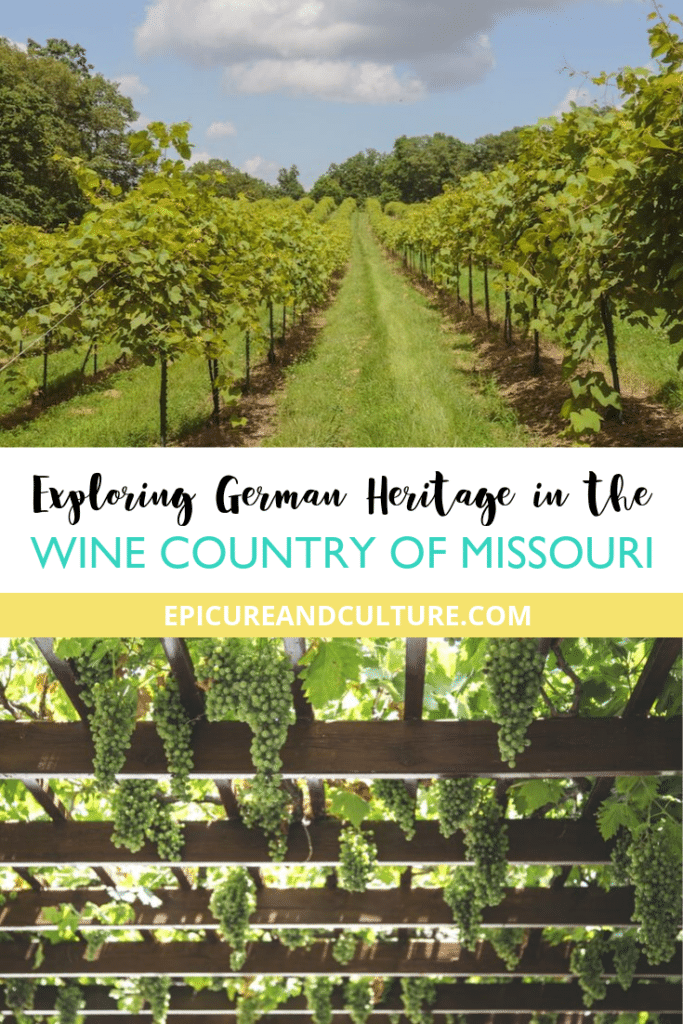By Alicia Erickson, Epicure & Culture contributor
Have you ever explored the wine country in Missouri?
Yes, you read that right.
Overshadowed by the chardonnays of northern California’s wine country and the pinot noirs of Oregon’s Willamette Valley, it is an oft-hushed secret that the roots of North America’s wine industry lie east of the Rocky Mountains from a time when Napa hadn’t even been dreamed of.
With the biggest pre-Prohibition wine-producing region being New York, the second was perhaps in an even more unexpected locale:
A midwestern Missouri town settled by German immigrants in the early-to-mid 19th century.
The gently rolling hills, rushing rivers, and temperate climate reminded Germans of the valleys of the Rhine, drawing them to settle Hermann, Missouri, which would quickly grow to be one of the country’s most prominent wine-producing regions of the late 19th and early 20th centuries.
Psst, don’t forget to pin this post for later!
History Of Wine Country In Missouri
Intending to preserve their small-town way of life, German immigrants began moving to the site of Hermann with the hopes of building a flourishing community reflective of their home country.
Wild vines of the native Norton grape varietal were found by early farmers in the region, leading founders of the town to believe that wine had great potential in the region.
Original vines were planted for viniculture purposes in the 1830s.
Michael Poeschel — one of the original wine pioneers in the region — spent 22 years digging an underground cellar, making it the largest of its kind in North America.
The proximity to the Gasconade and Missouri Rivers proved to be ideal for grape growing conditions, as the rivers kept the air flowing, which prevented frost in spring when grapes wake up.

From the mid-1800s up until Prohibition in 1920, Hermann and the surrounding valleys flourished with vineyards and wineries.
Wine was the main business of the town and 10,000 acres of vineyards were rich with grapes.
During a time of crisis in France, when phylloxera attacked French vines, Missouri wine farmers even sent over vines to help save the country’s grape source.

However, as prohibitionists infiltrated the region around 1919, machinery was confiscated, vines were burned, and barrels of wine were broken.
For days, the streets were flooded with red wine. A few barrels and vines remained hidden in cellars and deep in the forest, but the once-booming industry largely died out overnight.
Some farmers began to grow new types of crops, while others migrated elsewhere.
The town that was expected to be larger than Philadelphia became largely abandoned and forgotten about, while the American wine industry continued its migration westward, making its legacy in the slopes of Sonoma and Napa.
The Resurrection Of Hermann Wineries
In the 1960s, Hermann’s wineries started to slowly rise from the graves they had been buried in during Prohibition.
Families who still owned original land started to re-plant vines and farmers moved back to the area to buy land used for the original vines.
Grapes were replanted and, slowly, Missouri’s wine heritage began to be resurrected.
Wine country in #Missouri? Yes, it's a thing. Here is how to explore the best of the state's #wine culture!Missouri Vineyards: Contemporary Wineries In Hermann
Today, the little town of Hermann, Missouri is not much more than a single street lined with historic brick buildings, antique shops, and a handful of wineries.
The wide streets make the small-town feel even quieter.
They are a tribute to the original vision when the founders anticipated the town to grow larger than Philadelphia.

The Missouri wine region has regained much of its breadth, though still remains a relative secret to most of the world — and even the rest of the country.
For the most part, Missouri’s wine-growing region stretches along the Katy Trail and is concentrated in Hermann, Augusta, and New Haven.
Within the town of Hermann, you’ll find a preservation of German heritage and an homage to the original winemakers of Missouri.
The gently rolling hills, rich in green during late spring and summer, turn to shades of cayenne and gold as autumn months settle in.
Whether on a day-trip from St. Louis or a weekend escape, the unique German history and wine story of Hermann and its contemporary Missouri wineries are well worth a visit for vino enthusiasts and history buffs alike.
Where To Go When Exploring The Missouri Wine Trail
1. Robller Winery
The definition of a true family winery, Robller is the passion project of a father and son who have family roots in Missouri’s farmland and an age-old winemaking tradition.
Located down a gravel road in New Haven, a short drive outside of Hermann when heading west from St. Louis, Robller’s tasting room offers views over cultivated vineyards.
A true window into a small-scale, family-owned wine farm, Robller is rooted in a love for growing grapes and experimenting with wine.
Jerry, whose parents bought the farm in 1987, has taken over as primary winemaker of Robller.
Prior to owning the wine farm, his parents Robert and Lois — the founders and owners of the farm — made wine at home.
This tradition was carried on from their parents and grandparents who immigrated to the region from Germany in the 19th century.
Their immigration followed the spread of feudalism, which blockaded wine production in the Black Forest region of Germany, where they lived.
Love family-owned #wineries? Here is why #Missouri should be on your trip list!Jerry’s knowledge and passion for wine are omnipresent.
Combining his experiences growing up farming with his time working in the wine industry around the USA, Jerry blends the best of agricultural and wine production.

Robller is truly shaped by a love for the land and experimentation with winemaking.
Although Missouri’s grapes are different than traditional varietals, Jerry draws upon techniques from his favorite wines around the world and applies it to the Norton and Vignoles grapes, among others.
Through this approach, Robller produces wines that echo the best of both old world and Missouri wines.
The “St. Vincent Rose”, for example, uses the same yeast that French roses use.
Another example is the “Robller Vineyards Vidal Blanc,” which uses a grape native to Missouri and is aged in chinkapin barrels, a wood local to Missouri.
Although the wine picks up initial oaky notes, it eventually settles into a flavor profile of its own.


2. Hermannhof Winery
Hermannhof Winery remains a namesake for everything Hermann.
Incorporated into the vineyard is a farm, a bed & breakfast, a tasting room, and an associated restaurant and distillery.
Situated right in town, Hermannhof is the perfect spot to stop for both a history lesson and exposure to some of Missouri’s finest wines.
The buildings of Hermannhof date back to when they functioned as a brewery in 1852.
Inside, one can find angels on the wall, which were placed in the brewery to watch over the beer.
Originally just a small side-note to beer, wine production took off in the early 20th century.

After the resurrection of Hermann’s wine, Hermannhof became a forerunner in Missouri’s contemporary wine scene.
The first vines were planted in 1978, some of which are still used in today’s production.
Hermannhof remains dedicated to preserving wine’s natural characteristics in the production process.

An homage to the German heritage of the town is blended with contemporary wine techniques at Hermannhof to produce some of Missouri’s most standout wines.
The “White Lady Wine” is Hermannhof’s oldest and best-selling; a tribute to a traditional German-style riesling.
For those who prefer a drier glass of wine, the “Reserve Vignoles” and the medium-bodied red “Chambourcin” provide phenomenal offerings.
Also not to be miss:
The “Brut Reserve”; a light, mineral-forward sparkling from Vidal grapes.
3. Adam Puchta Winery
Adam Puchta’s fascinating history is a true testament to the original wine of Hermann.
Today the winery is owned by Tim Puchta, the great-great-grandson of Adam, who was the namesake and first owner of the winery.
A short drive away from the town center of Hermann, Adam Puchta Winery is set against expansive land, where grapes are grown and pressed and are available for sampling in the tasting room.

Adam, who immigrated with his parents from Germany in the early 19th century, was among the original wine pioneers of Hermann.
His son Henry eventually joined in the family business, known then as Adam Puchta and Son Wine Company.
The original Puchta family vineyard was 1,000 acres and was believed to have produced 10,000 gallons of wine.
Sadly, though, they became victims of the temperance movement, and these vineyards, alongside other Hermann vineyards, were destroyed in 1919 and 1920.
Their land eventually dwindled to just 86 acres.
Although wine production for business was banned, the Puchta family still produced wine on a small-scale for family use, using blackberries, elderberries, and a few wild Norton grapes.
Did you know #Missouri has a #wine culture that has German roots? And we've made it easy to explore with this guide to the state's wine country!As the impact from prohibition wore off and wine was starting to make a comeback in Hermann, Tim and his father Randolph — professionals in medicine and law — left their respective fields to bring a life-long dream to fruition:
Reopening the original Puchta farm for viniculture purposes.
Still in possession of some of the original land their ancestors once cultivated grapes on, the father-son duo began to replant grapes on the Puchta family’s plot of land.
They first planted three acres of Norton grapes and renovated the original stone home, which is now the tasting room.
By 1990, the vineyard was back in business and reopened to the public.
Adam Puchta Winery has continued to expand in production over the years, though has retained an intimate feel.
They grow their own grapes and produce their own wine, with family remaining at the heart of the business’ ethos.
The slopes of the property come alive with concerts and benefit events during spring through autumn months.
Tim’s son, a culinary professional, designs wholesome Midwest-inspired menus for the events, while an impressive selection of wines — from traditional Nortons to sophisticated Ports to easy-drinking summer whites and blends of fruit wines — are on offer.
Perhaps one of the most notable wines is the “1855 Port,” named for the year in which Adam Puchta founded the winery.
An elegant caramel taste lingers on the palette while sipping this sophisticated dessert wine.
4. Stone Hill Winery
Another winery steeped in old history, Stone Hill is home to the famed underground cellar that took 22 years to construct.
Today, it remains the largest underground cellar in the United States.
While the barrels of wine are still stored deep beneath the ground, the tasting room of the winery is set atop a hill providing an unhindered view over the town of Hermann.
Michael Poeschel, the original owner, came to Hermann because it reminded him of the Rhine Valley in Germany.
When farming, he discovered Norton grapes growing wild and realized the potential of wine in the region.
Stone Hill’s original farm was founded in 1847 and became a significant producer during the peak era.
They shipped wines around the country and worldwide, winning awards at world fairs in Philadelphia and Vienna.
After the vineyard was shut down during Prohibition, the cellars were used to grow mushrooms.
Eventually, former local farmers, Jim and Betty, bought the farm in 1965.
Although they were pig farmers by trade, they had their own personal block of Norton grapes from which they made wine for the family.
After restoring Stone Hill, the farm was passed along to their son John and his wife Karen who own the winery today.
Stone Hill stands out as one of the largest wine producers in Hermann, offering sparkling, dry reds and whites, and dabbling in the semi-sweet and sweet wines that are characteristic of many Missouri wines.
If you’re feeling hungry after a day of wine tasting, head next door to Stone Hill’s Vintage Restaurant that draws upon traditional, hearty German cuisine.

Where To Stay When Visiting Wineries In Missouri
Inn at Hermannhof offers a cozy stay with a twist of history for those looking for a getaway to Hermann while visiting the wineries.
With a decadent bed and breakfast in the town center and wine cellars converted into small houses on the hills overlooking Hermann, the Inn is steeped in history and a design aesthetic that offers a nod towards the 19th century.
The wine cellars are constructed from stone used during Hermann’s original wine production.
Many of the cellars were moved by hand from their original spots and reconstructed closer to town, keeping the arrangement of stones.
The cottages offer a taste of history and comfort inside and out, decorated with the spirit of the mid-1800s and the comforts of the 21st century in mind and the best views in town.

Beyond Missouri Wineries
Looking for something else to explore when in the little town of Hermann?
The Missouri destination is packed with enough wineries to keep one busy and buzzed for days, though the town’s history is also worth exploring.
Hermann Farm provides a glance at what homes, farms, and trading posts looked like in the peak of German colonization.
Deutschheim State Historic Site offers a more intimate glance into German heritage, providing tours to a wine-producing home and wine bar that were in operation during the 19th century. Antique shops are aplenty, as well.

For something unexpected, stop by Martin Brothers Winery on the road between Adam Puchta Winery and town.
Martin Brothers is a passion project of two brothers who have a keen interest in mead, a honey-based wine that can act almost as a liqueur.
Have you tried #mead? #Missouri makes some of the best. Here's where to try it for yourself!Seeking out the best honey from around the world, they set to work distilling and fermenting the honey.
Wildflower, orange, and other varietals are available based on the type of honey.
The mead is rich in orange and golden hues, offering floral and citrus dimensions to the smooth, semi-sweet wine.
Hermann, although open year-round for wine and history exploration, is particularly lively during the month of October.
This is when Oktoberfest events take place each weekend commemorating the German heritage of the town that still thrives nearly two centuries since its founding.
Have you explored wine country in Missouri? Share your experience in the comments below!
Enjoyed this post? Pin it for later!
Alicia Erickson
Latest posts by Alicia Erickson (see all)
- Wild Spirit: A Sustainable Retreat Along South Africa’s Garden Route - Nov 24, 2019
- Wine Country In Missouri: Exploring German Heritage At The Wineries Of Hermann - Sep 16, 2019
- Best African Beer: This Victoria Falls Brewery Is Changing Zimbabwe’s Brew Scene - Aug 18, 2019
- Sustainable Tourism In South Africa: Luxury Safaris For Conscious Travelers - Jun 21, 2019
- Durbanville Wine Valley: A Tipsy Guide To This Lesser-Known South Africa Wine Region - Jun 11, 2019








This is such a detailed post. A lot of information presented.
Great pics and storyline. I would have never associated Missouri and Germans with great wine. I love their selection of reds and a quaint little town to top it off.
Been there once, it was really fun and very tasty too!